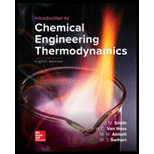
Interpretation:
The steam rate through the turbine and the turbine efficiency under the given conditions needs to be calculated
Concept Introduction:
- The energy balance equation that relates the inlet and outlet enthalpies and velocities is given based on the first law of
thermodynamics as:
- For an adiabatic process, there is no loss or gain of heat i.e. q = 0
The process occurs at constant enthalpy, i.e. isentropic
- The isentropic efficiency of a turbine is given as:
Steam rate = 4.1 kg/s
Turbine efficiency = 0.82
Given Information:
Inlet pressure of steam, P1 = 2400 kPa
Inlet Temperature of steam T1=
Outlet pressure of steam, P2 = 20 kPa
Power output = 3500 KW
Explanation:
Based on the steam tables, for inlet conditions: P1 = 2400 kPa, T1=
Specific enthalpy of vapor H1= 3462.9 kJ/kg
Specific entropy of vapor, S1=7.3439 kJ/kg-K
For outlet at P2 = 20 kPa
Specific enthalpy of vapor H2= 2609.9 kJ/kg
Step 1:
Calculate the steam rate through the turbine
Based on equation (1) we have:
Step 2:
Calculate the adiabatic (isentropic) enthalpy at the exit
Since this is an isentropic process, S2 = S1 = 7.3429 kJ/kg-K
Based on the steam tables at outlet, P2 = 20 kPa the value of S2 = 7.3429 kJ/kg-K represents ‘wet’ steam.
At 20 kPa: Sf = 0.8321 kJ/kg-k and Sg = 7.9094 kJ/kg-k
Step 3:
Calculate the turbine efficiency
Based on equation (5) we have:
Thus, steam rate = 4.1 kg/s
Turbine efficiency = 0.82
Want to see the full answer?
Check out a sample textbook solution
Chapter 7 Solutions
Introduction to Chemical Engineering Thermodynamics
 Introduction to Chemical Engineering Thermodynami...Chemical EngineeringISBN:9781259696527Author:J.M. Smith Termodinamica en ingenieria quimica, Hendrick C Van Ness, Michael Abbott, Mark SwihartPublisher:McGraw-Hill Education
Introduction to Chemical Engineering Thermodynami...Chemical EngineeringISBN:9781259696527Author:J.M. Smith Termodinamica en ingenieria quimica, Hendrick C Van Ness, Michael Abbott, Mark SwihartPublisher:McGraw-Hill Education Elementary Principles of Chemical Processes, Bind...Chemical EngineeringISBN:9781118431221Author:Richard M. Felder, Ronald W. Rousseau, Lisa G. BullardPublisher:WILEY
Elementary Principles of Chemical Processes, Bind...Chemical EngineeringISBN:9781118431221Author:Richard M. Felder, Ronald W. Rousseau, Lisa G. BullardPublisher:WILEY Elements of Chemical Reaction Engineering (5th Ed...Chemical EngineeringISBN:9780133887518Author:H. Scott FoglerPublisher:Prentice Hall
Elements of Chemical Reaction Engineering (5th Ed...Chemical EngineeringISBN:9780133887518Author:H. Scott FoglerPublisher:Prentice Hall
 Industrial Plastics: Theory and ApplicationsChemical EngineeringISBN:9781285061238Author:Lokensgard, ErikPublisher:Delmar Cengage Learning
Industrial Plastics: Theory and ApplicationsChemical EngineeringISBN:9781285061238Author:Lokensgard, ErikPublisher:Delmar Cengage Learning Unit Operations of Chemical EngineeringChemical EngineeringISBN:9780072848236Author:Warren McCabe, Julian C. Smith, Peter HarriottPublisher:McGraw-Hill Companies, The
Unit Operations of Chemical EngineeringChemical EngineeringISBN:9780072848236Author:Warren McCabe, Julian C. Smith, Peter HarriottPublisher:McGraw-Hill Companies, The





